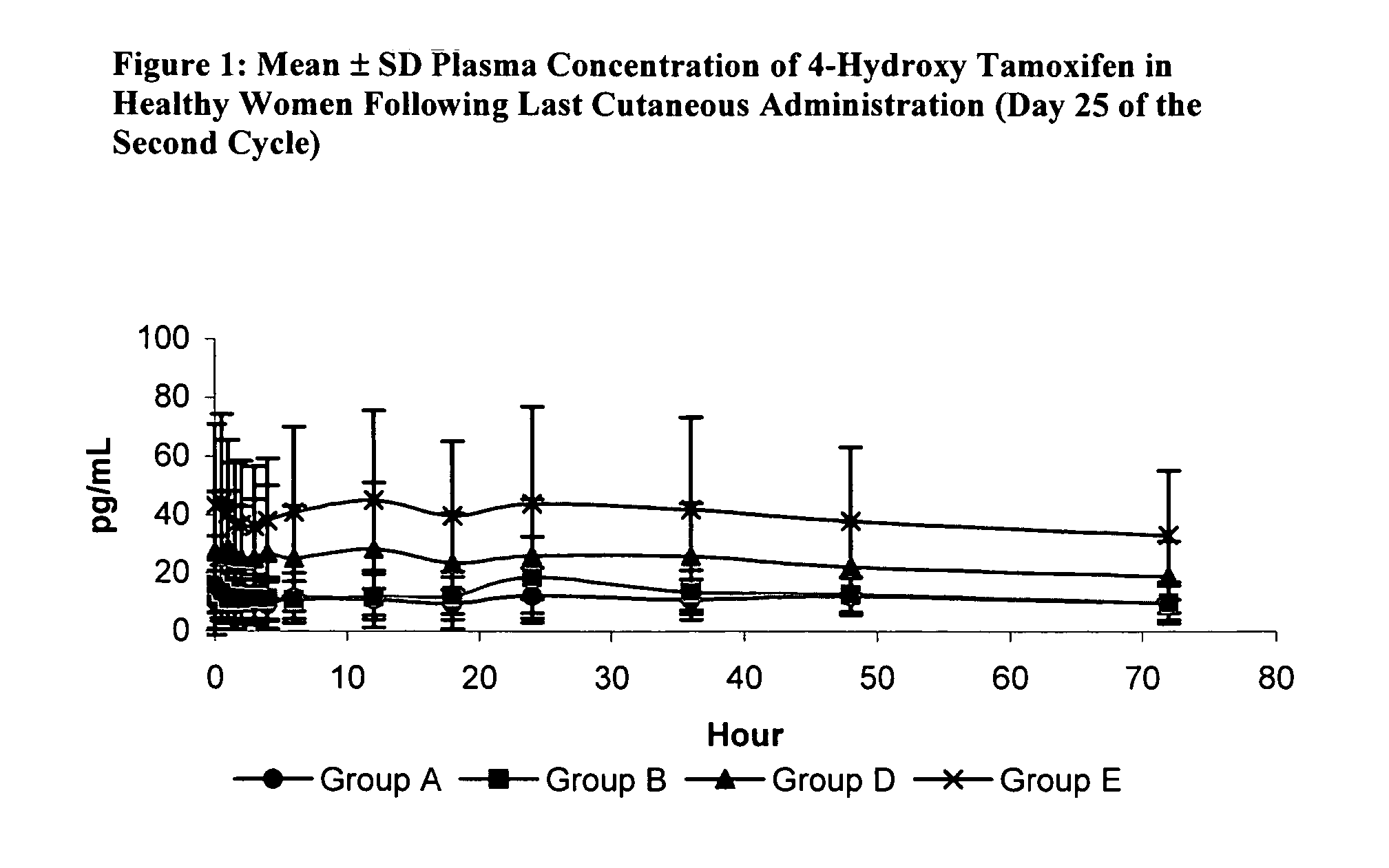Treatment of mastalgia with 4-hydroxy tamoxifen
- Summary
- Abstract
- Description
- Claims
- Application Information
AI Technical Summary
Benefits of technology
Problems solved by technology
Method used
Image
Examples
example 1
Demonstration of Percutaneous 4-Hydroxy Tamoxifen Delivery
[0037] Four patients with breast cancer received [3H]-4-hydroxy tamoxifen in an alcoholic solution applied directly to the breasts at specified intervals between 12 hours to 7 days prior to surgery to excise diseased tissue. After surgery, both the excised tissue and the normal breast tissue surrounding the tumor contained radioactivity (Kuttenn et al., 1985).
[0038] In a follow-up study, 9 of 12 patients scheduled for surgical excision of hormone-dependent breast cancer received trans-[3H]-4-hydroxy tamoxifen (80 μCi) in a 60% alcoholic solution, and 3 patients received trans-[3H]-tamoxifen (80 μCi) for comparison. The patients received [3H]-labeled drug applied directly on the affected breasts at specified intervals ranging from 12 hours to 7 days before surgery to excise diseased tissue. Breast tissue from three regions: the tumor, tissue immediately surrounding the tumor, and normal tissue, was excised and immediately fr...
example 2
Demonstration of the Pharmacokinetics and Pharmacodynamics of Percutaneously Administered 4-OH-Tamoxifen Compared to 20 mg of Oral Tamoxifen
[0045] This study compared the tissue and plasma concentrations of 4-hydroxy tamoxifen after percutaneous administration via a hydroalcoholic gel with tissue and plasma concentrations of 4-hydroxy tamoxifen after oral administration of tamoxifen. (Pujol et al.).
[0046] Thirty-one patients scheduled for breast cancer surgery were randomly assigned to 1 of 5 groups. They received treatment with either oral tamoxifen or percutaneous 4-hydroxy tamoxifen as outlined in Table 3. Treatment was daily and lasted for 3-4 weeks prior to surgery. The study evaluated three different doses of 4-hydroxy tamoxifen (0.5, 1, or 2 mg / day) and two areas of application (either to both breasts or to a large surface of skin including arms, forearms, and shoulders). One group of patients received 20 mg / day (10 mg b.i.d.) of oral tamoxifen (Nolvaldex®).
TABLE 3Treatme...
example 3
Demonstration of Tolerance and Pharmacokinetics of Percutaneously Administered 4-OH-Tamoxifen in Healthy Women
[0053] This study demonstrates the tolerance and pharmacokinetics of topically applied 4-hydroxy tamoxifen gel in healthy premenopausal women, aged 18-45. Each participant applied the gel daily for the duration of two menstrual cycles.
[0054] Three doses and two gel concentrations were tested, as summarized in Table 5. For Groups A-C, the gel, containing 20 mg of 4-hydroxy tamoxifen / 100 g, was dispensed from a pressurized dose-metering pump that delivered 0.25 mg of 4-hydroxy tamoxifen / dose. The study of Group C was suspended because the quantity of gel was too large to be applied to a single breast. Groups D and E received a more concentrated gel that contained almost 3 times as much 4-hydroxy tamoxifen: 57 mg of 4-hydroxy tamoxifen / 100 g, or 50 mg of 4-hydroxy tamoxifen / 100 mL of gel. This more concentrated gel also was delivered by a dose-metering pump that supplied 0.25...
PUM
| Property | Measurement | Unit |
|---|---|---|
| Mass | aaaaa | aaaaa |
| Mass | aaaaa | aaaaa |
| Mass | aaaaa | aaaaa |
Abstract
Description
Claims
Application Information
 Login to View More
Login to View More - R&D
- Intellectual Property
- Life Sciences
- Materials
- Tech Scout
- Unparalleled Data Quality
- Higher Quality Content
- 60% Fewer Hallucinations
Browse by: Latest US Patents, China's latest patents, Technical Efficacy Thesaurus, Application Domain, Technology Topic, Popular Technical Reports.
© 2025 PatSnap. All rights reserved.Legal|Privacy policy|Modern Slavery Act Transparency Statement|Sitemap|About US| Contact US: help@patsnap.com


